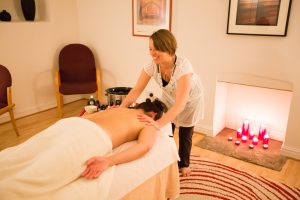In our final article for Migraine Awareness Week, Rowan Jamal looks at some research evidence on how massage helps treat migraine, and in particular looks at the benefits of aromatherapy

When the trigger for your migraine is associated with stress, tight muscles – particularly in the shoulders and neck – poor sleep, strong emotions such as shock, anxiety, excitement or depression, then massage can help relieve the impact of these on the body, lessening the chance of migraine symptoms.
Massage treatment can be useful for short-term relief, and also when incorporated into your self-care it can help on a more long-term basis. This is because it then helps the body to maintain equilibrium and balance where the parasympathetic nervous system (the relaxation side of the nervous system) is more engaged and dominant.
Research evidence of benefit of massage
There has been some positive research in the few clinical studies on the effects of massage on migraine.
One 2006 study of 47 migraine sufferers randomly assigned participants to receive massage therapy or to a control group (Lawler and Cameron, 2006; Hernandez-Rief et all, 1998). All trial participants completed daily assessments of their sleep activity and migraine attacks.
Those who had massages had fewer migraines and slept better during the weeks they had massages and in the three weeks following massages. On average, the massage group had a 34% reduction in migraines during the weeks they received massage therapy and a 30% reduction in the follow-up period, compared to reductions of 7% and 2% in the control group.
Another randomised study evaluated 26 people with migraine (Hernandez et al, 1998). Half of the participants received massage therapy, focusing on the neck. Those who received massage had significantly less migraine pain compared to the control group. From the first massage to the last, the massage group reported a 71% reduction in pain intensity.
How does massage help?
Massage is a great way to reduce stress and relieve tension in the body as a whole, also targeting tight muscles at the back of the neck up into the base of the skull freeing up the blood and energy flow to the head. I also do hot-stone massage using hot and cold stones, which can intensify muscle relaxation and aid detoxification.
In a hot-stone massage, the hot stones dilate the blood vessels and the cold-stones contract them – this combination is good for relaxing the muscles and flushing out the toxins.
Benefits of aromatherapy

Lavender and peppermint oil have both undergone some research into their effects for helping minor migraines. They can be used in the massage and at home applied to the skin in an oil, in a bath mixed either with an oil or a fatty substance such as milk, or inhaled.
Some essential oils can reduce stress to help overcome the build up of symptoms, which could lead to a migraine trigger. Some of these are:
- peppermint oil, which contains menthol helping muscles relax and easing pain
- rosemary, which has powerful anti-inflammatory and analgesic properties
- lavender, a common oil for the treatment of stress relief
- roman chamomile oil, whose sedative anti-depressant properties exhibit benzodiazepine-like hypnotic activity, helping insomnia and restlessness.
I’d be happy to answer any specific questions you may have, if you would like to call me direct on 07905 057109. Wishing everyone a very good week with lots of time for rest and nurturing the body and spirit.
References:
- Lawler, S.P. and Cameron, L.D. (2006) ‘A randomised, controlled trial of massage therapy as a treatment for migraine’, Annals of Behavioural Medicine, August, vol 32, no 1, pp50-59
- Hernandez-Rief, M., Dieter, J., Field, T., Swerdlow, B. and Diego, M. (1998) Migraine headache reduced by massage therapy. International Journal of Neuroscience, Volume 96, Issue 1–2
For information on how other therapies can help, see the other articles in this series:
- Our massage therapist Piia Laakso shares how her specific approach can help both prevent migraine and relieve the pain of existing headaches
- Orla Kirby shares how hypnotherapy can help your body treat migraines with its own natural resources
- Julie Kelham explains how acupuncture can help treat the root cause of migraines



